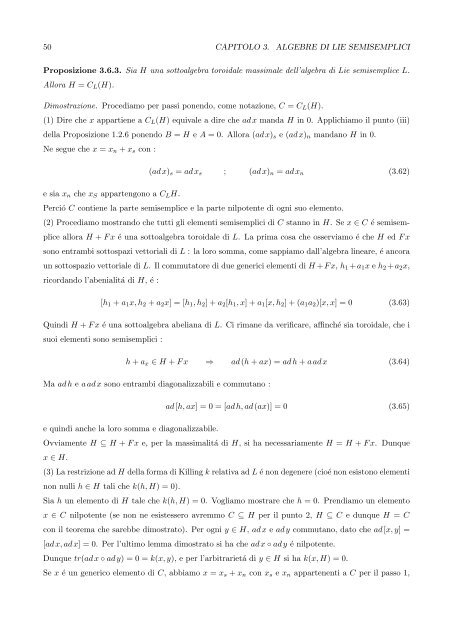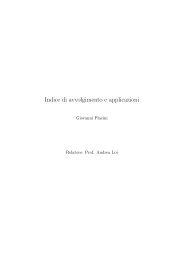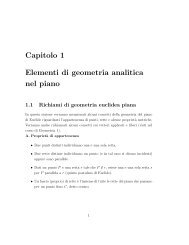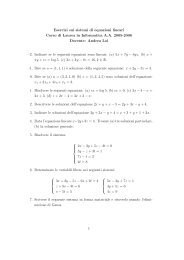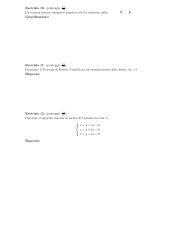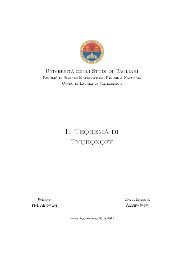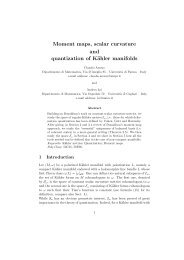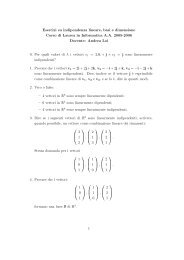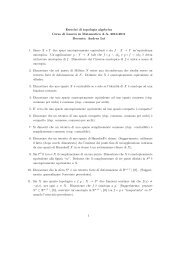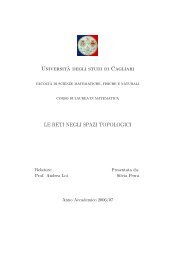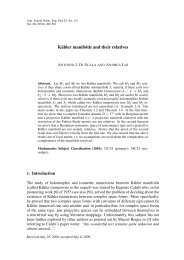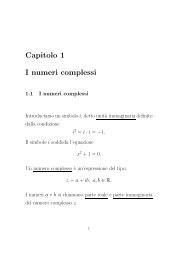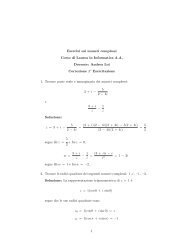Algebre di Lie semisemplici, sistemi di radici e loro classificazione
Algebre di Lie semisemplici, sistemi di radici e loro classificazione
Algebre di Lie semisemplici, sistemi di radici e loro classificazione
Create successful ePaper yourself
Turn your PDF publications into a flip-book with our unique Google optimized e-Paper software.
50 CAPITOLO 3. ALGEBRE DI LIE SEMISEMPLICI<br />
Proposizione 3.6.3. Sia H una sottoalgebra toroidale massimale dell’algebra <strong>di</strong> <strong>Lie</strong> semisemplice L.<br />
Allora H = CL(H).<br />
Dimostrazione. Proce<strong>di</strong>amo per passi ponendo, come notazione, C = CL(H).<br />
(1) Dire che x appartiene a CL(H) equivale a <strong>di</strong>re che ad x manda H in 0. Applichiamo il punto (iii)<br />
della Proposizione 1.2.6 ponendo B = H e A = 0. Allora (ad x)s e (ad x)n mandano H in 0.<br />
Ne segue che x = xn + xs con :<br />
e sia xn che xS appartengono a CLH.<br />
(ad x)s = ad xs ; (ad x)n = ad xn (3.62)<br />
Perció C contiene la parte semisemplice e la parte nilpotente <strong>di</strong> ogni suo elemento.<br />
(2) Proce<strong>di</strong>amo mostrando che tutti gli elementi <strong>semisemplici</strong> <strong>di</strong> C stanno in H. Se x ∈ C é semisem-<br />
plice allora H + F x é una sottoalgebra toroidale <strong>di</strong> L. La prima cosa che osserviamo é che H ed F x<br />
sono entrambi sottospazi vettoriali <strong>di</strong> L : la <strong>loro</strong> somma, come sappiamo dall’algebra lineare, é ancora<br />
un sottospazio vettoriale <strong>di</strong> L. Il commutatore <strong>di</strong> due generici elementi <strong>di</strong> H +F x, h1 +a1x e h2 +a2x,<br />
ricordando l’abenialitá <strong>di</strong> H, é :<br />
[h1 + a1x, h2 + a2x] = [h1, h2] + a2[h1, x] + a1[x, h2] + (a1a2)[x, x] = 0 (3.63)<br />
Quin<strong>di</strong> H + F x é una sottoalgebra abeliana <strong>di</strong> L. Ci rimane da verificare, affinché sia toroidale, che i<br />
suoi elementi sono <strong>semisemplici</strong> :<br />
h + ax ∈ H + F x ⇒ ad (h + ax) = ad h + a ad x (3.64)<br />
Ma ad h e a ad x sono entrambi <strong>di</strong>agonalizzabili e commutano :<br />
e quin<strong>di</strong> anche la <strong>loro</strong> somma e <strong>di</strong>agonalizzabile.<br />
ad [h, ax] = 0 = [ad h, ad (ax)] = 0 (3.65)<br />
Ovviamente H ⊆ H + F x e, per la massimalitá <strong>di</strong> H, si ha necessariamente H = H + F x. Dunque<br />
x ∈ H.<br />
(3) La restrizione ad H della forma <strong>di</strong> Killing k relativa ad L é non degenere (cioé non esistono elementi<br />
non nulli h ∈ H tali che k(h, H) = 0).<br />
Sia h un elemento <strong>di</strong> H tale che k(h, H) = 0. Vogliamo mostrare che h = 0. Pren<strong>di</strong>amo un elemento<br />
x ∈ C nilpotente (se non ne esistessero avremmo C ⊆ H per il punto 2, H ⊆ C e dunque H = C<br />
con il teorema che sarebbe <strong>di</strong>mostrato). Per ogni y ∈ H, ad x e ad y commutano, dato che ad [x, y] =<br />
[ad x, ad x] = 0. Per l’ultimo lemma <strong>di</strong>mostrato si ha che ad x ◦ ad y é nilpotente.<br />
Dunque tr(ad x ◦ ad y) = 0 = k(x, y), e per l’arbitrarietá <strong>di</strong> y ∈ H si ha k(x, H) = 0.<br />
Se x é un generico elemento <strong>di</strong> C, abbiamo x = xs + xn con xs e xn appartenenti a C per il passo 1,


